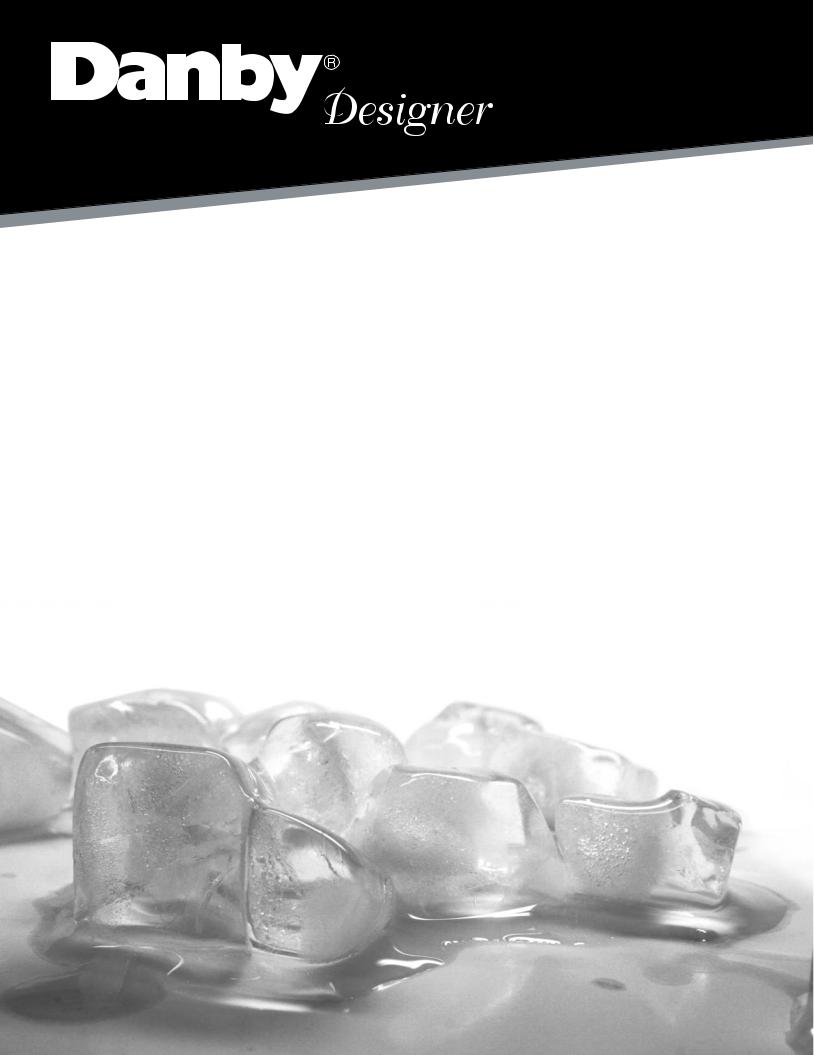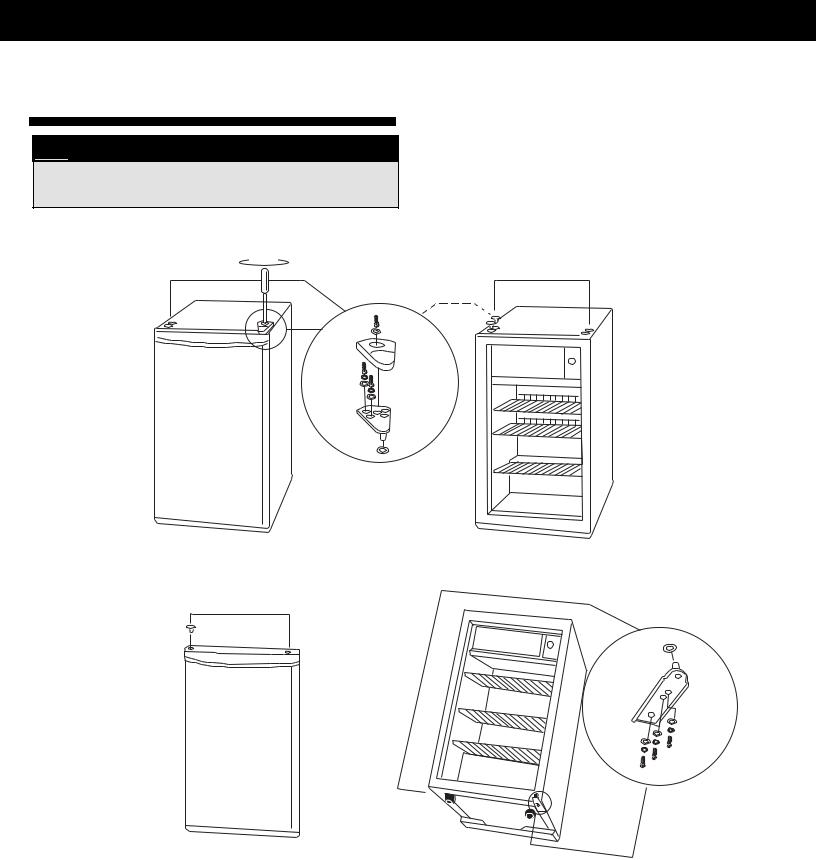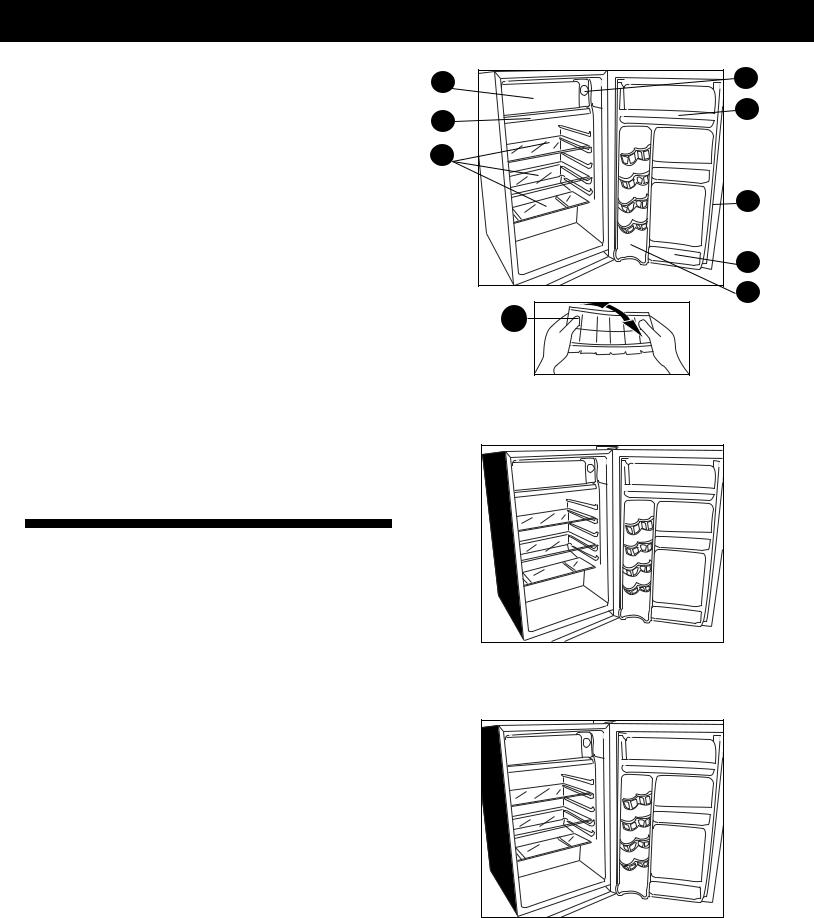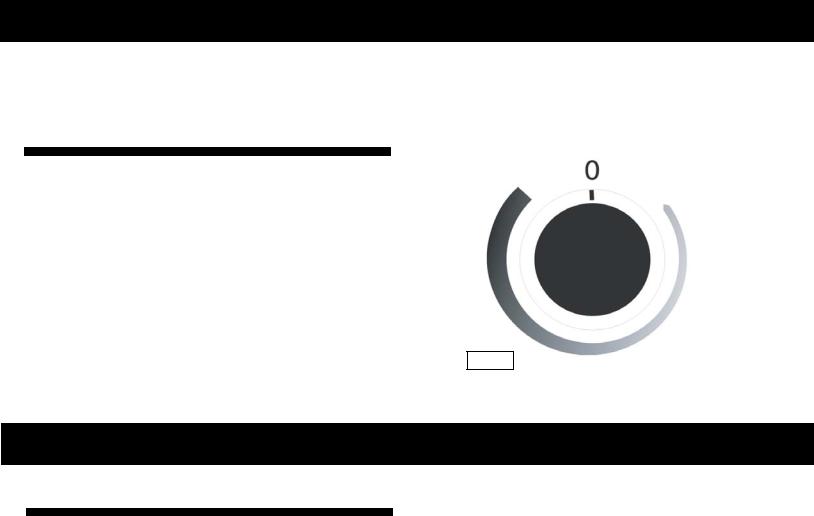Danby DCR122BSLDD User Manual

•COMPACT REFRIGERATOR
•RÉFRIGÉRATEUR COMPACT
•REFRIGERADOR COMPACTO
Owner’s Use and Care Guide
Guide d’utilisation et soins de Propriètaire
Manual de Instructions pare el Uso y Cuidado de su Unidad
Model • Modèle • Modelo
DCR122WDD - DCR122BLDD - DCR122BSLDD
V5.01.11 DM

CONTENTS
COMPACT REFRIGERATOR |
|
Owner’s Use and Care Guide |
2-8 |
•Safety Instructions
•Installation Instructions
•Features
•Operating Instructions
•Care and Maintenance
•Troubleshooting
•Warranty
RÉFRIGÉRATEUR COMPACT |
|
Guide d’utiliser et soin de propriètaire |
9-15 |
•Consignes de sécurité
•Consignes de Installation
•Caracteristiques
•Opération
•Soins et entretien
•Dépannage
•Garantie
REFRIGERADOR COMPACTO |
|
Guía para utilizar y cuidar del Proprietario |
16-22 |
•Instruciónes de Seguridad Importantes
•Instrucciones d’instalación
•Caracteristicas
•Instruciónes Operadoras
•Limpieza y Mantenimiento
•Solución Sugeridad
•Garantia
 CAUTION
CAUTION
Read and follow all safety rules and operating instructions before first use of this product.
 PRECAUTION
PRECAUTION
Veuillez lire attentivement les consignes de sécurité et les instructions d’utilisation avant l’utilisation initiale de ce produit.
 PRECAUCION
PRECAUCION
Lea y observe todas las reglas de seguridad y las instrucciones de operación antes de usar este producto por primera vez.
1

IMPORTANT SAFETY INFORMATION
READ ALL SAFETY INFORMATION BEFORE USING
ELECTRICAL REQUIREMENTS
This appliance must be grounded. In the event of an electrical short circuit, grounding reduces the risk of electrical shock by providing an escape wire for the electrical
current.
This appliance is equipped with a cord having a grounding wire with a grounding plug. The plug must be plugged into an outlet that is properly installed and grounded.
 WARNING
WARNING
Improper use of the grounding plug can result in a risk of electric shock. Consult a qualified electrician or serviceman if the grounding instructions are not completely understood, or if doubt exists as to whether the appliance is properly grounded.
DO NOT USE AN EXTENSION CORD
Use an exclusive wall outlet. Do not connect your refrigerator to extension cords or together with any other appliance in the same wall outlet. Do not splice the cord.
IMPORTANT WARNING:An empty refrigerator is a very dangerous attraction to children. Remove either the gasket, latches, lids or doors from unused appliances, or take some other action that will guarantee it harmless.
DANGER: Risk of Child Entrapment! Before you throw away your old refrigerator/freezer:
•Take off the doors.
•Leave the shelves in place so that children may not easily climb inside.
DON’T WAIT! DO IT NOW!
SAVE THESE INSTRUCTIONS
INSTALLATION INSTRUCTIONS
LOCATION
Remove exterior and interior packaging, wipe the outside thoroughly with a soft dry cloth and the inside with a wet, lukewarm cloth. Avoid placing the unit in a narrow recess or near any heat source, direct sunlight, or moisture. Let air circulate freely around the unit. Keep the rear of the refrigerator 5 inches away from the wall.
Location
1)Select a place with a level floor.
2)Allow 5 inches of space between the back of the refrigerator and any adjacent wall.
3)Avoid direct sunlight and heat. Direct sunlight may affect the acrylic coating. Heat sources
nearby will cause higher electricity consumption.
4)Avoid damp places. Too much moisture in the air will cause frost to form very quickly on the evaporator, and your refrigerator will have to be defrosted more frequently.
2

INSTALLATION INSTRUCTIONS
DOOR REVERSAL
INSTRUCTIONS
 CAUTION
CAUTION
To avoid personal injury to yourself and/or property, we recommend someone assist you during the door reversal process.
If you find the direction of opening the door on your appliance inconvenient, you can change it by following the steps shown in the below diagrams.
A B
Fig. 1 |
Fig. 2 |
C
Fig. 3 |
Fig. 4 |
3

FEATURES
1)THERMOSTAT DIAL: For controlling the temperature inside the refrigerator; the compressor activates as soon as the temperature rises above the desired level.
2)FREEZER COMPARTMENT WITH FREEZER DOOR:
Separate freezer section holds ice cube tray and small items.
3)ICE CUBE TRAY: Ice cubes are easily removed from tray.
4)GLASS SHELVES
5)DRIP TRAY: Catches the water that drips off the evaporator when defrosting.
6)MAGNETIC GASKET: Tight fitting door seal keeps all the cooling power locked inside. No hooks or latches.
7)BOTTLE RACK: For tall, medium, and large bottles, cans or jars.
8)CANSTORTM Door Liner: Holds 355mL cans of pop, juice, or beer.
9)EGG TRAY
ICE CUBE TRAY
Ice cube tray is flexible. Twist tray to remove ice cubes. If the ice cube tray is frozen hard to the evaporator surface, run a little water over the tray. Never use a knife or other metal instrument to remove ice cube tray as this may damage the evaporator.
2 |
1 |
|
|
5 |
9 |
|
|
4 |
|
|
6 |
|
7 |
|
8 |
|
3 |
DCR122BLDD |
DCR122BSLDD |
4

OPERATING INSTRUCTIONS
To avoid vibration, the unit must be set level. This is accomplished by adjusting the (1) front leveling leg located under the refrigerator. The temperature of the refrigerator is controlled by setting the thermostat knob to a desired setting.
TEMPERATURE SELECTION
To start the refrigerator, turn the temperature control knob to the position corresponding to the desired cooling (on the graduated blue dial) in Fig. A. The refrigerator temperature will vary depending on the quantity of the food stored, and on the frequency with which the door is opened.
To turn the control to the “OFF” position, rotate the control knob to the “0” setting. After defrosting and if the refrigerator has been left out of use for some time, set the control to maximum for 2 to 3 hours before turning to the desired position. If the refrigerator is not to be used for long time periods, disconnect the plug and leave the door partially open.
This will help reduce the mold/mildew from accumulating Fig. A inside the refrigerator cabinet.
CARE AND MAINTENANCE
DEFROSTING
This refrigerator is equipped with a “Push Button” (semi-automatic) defrost thermostat system. To
activate the defrost cycle, simply push (in) the red defrost button located in the center of the control knob/dial (do not turn the control knob/dial to zero/off). The defrost cycle is initiated immediately. When defrosting is complete, the “Push Button” will release (pop-out) automatically and resume normal operating conditions at the same temperature setting.
NOTE: If the “Push Button” is activated (pushed-in) accidentally, it will not be possible to “manually”
pull-out the push button (deactivate the defrost cycle). You must let the defrost cycle run its course. (or) Apply (hold) a dishcloth soaked in hot water against the thermostat capillary line and bracket, located on the underside of the freezer compartment. The heat transfer from the dish cloth will cause a temperature rise on the thermostat capillary (sensing line), causing the internal contacts to close. This will resume normal operating conditions. It may take several minutes and/or repeat applications before the push button will release.
Defrosting of your refrigerator should take place
whenever ice build-up inside the freezer compartment reaches 1/4” (6mm) thick. Defrosting may take a few hours, depending on the amount of accumulated ice and ambient indoor temperature. To speed up the defrosting process, remove all frozen foods from the freezer section. Leaving the door partially ajar for a short period of time will also speed up the process.
Important: You must remember to close the refrigerator door before the defrost cycle terminates and normal operating conditions resume automatically. The drip tray should be in position directly below the freezer compartment to catch condensed water during defrosting.
Note: Never use sharp or pointed instruments to remove ice from the freezer compartment. The freezer compartment contains refrigerated gas lines and if accidentally punched/pierced, will render the
refrigerator inoperable and void the manufacturers warranty.
DO NOT ALLOW THE REFRIGERATOR TO CONTINUE OPERATION IF THE FREEZER COMPARTMENT IS PIERCED.
After defrosting is complete, set the control to maximum for 2 to 3 hours before returning to the desired position. When the refrigerator is not to be used for a long period of time, disconnect the appliance from the electrical supply and leave the door partially open. This will help to reduce mold and mildew build-up.
Note: Wait 3 to 5 minutes before attempting to restart the refrigerator if operation has been interrupted.
5

CARE AND MAINTENANCE
CLEANING
To clean the inside, use a soft cloth and a mixture of one tablespoon of baking soda to one quart of water. Other cleaning options are a mild soap suds solution, or mild detergent. Wash glass shelves in a mild detergent solution, then dry and wipe with a soft cloth. Clean the outside with a soft damp cloth and some mild detergent or appliance cleaner.
POWER FAILURE
Most power failures are corrected within an hour or two and will not affect your refrigerator temperatures. However, you should minimize the number of door openings while the power is off. During power failures of longer duration, take steps to protect your food by placing dry ice on top of packages.
IF YOU MOVE
Remove or securely fasten down all loose items inside the unit. To avoid damaging the leveling legs, turn them all the way into the base.
FOOD STORAGE SUGGESTIONS
Fresh Food Compartment
•Never cover food compartment shelves with aluminum foil or any other shelf covering material which may prevent air circulation.
•Always remove porous store wrapping paper from meats, poultry and fish. Meats should be wrapped individually and placed in a dish for storage. Wrap fish and poultry in foil or heavy waxed paper. Most fish should be used the same day of purchase. Packaged meats such as ham, bacon, dried beef, or frankfurter, store best in their original packages.
•Allow warm foods to cool to room temperature before placing them in the refrigerator.
•Always cover open dishes of food, especially leftovers. Use leftovers within 2 or 3 days.
VACATION TIME
For short vacation periods, leave the control knob at its normal setting. During longer absences:
(a)remove all foods.
(b)disconnect power cord from electrical outlet.
(c)clean the refrigerator thoroughly, including drip tray (defrost pan).
(d)leave door open to avoid possible formations of condensate, mold or odors.
Some Important Rules for the Correct Use of the Refrigerator
•Never place hot foods in the refrigerator.
•Never place spoiled foods in the unit.
•Don’t overload the unit.
•Don’t open the door unless necessary.
•Should the refrigerator be stored without use for long periods, it is suggested, after a careful cleaning, to leave the door ajar to allow the air to circulate inside the unit in order to avoid the possibility of condensation, mold or odors.
6

TROUBLESHOOTING
Occasionally, a problem is minor and a service call may not be necessaryuse this troubleshooting guide for a possible solution. If the unit continues to operate improperly, call an authorized service depot or Danby’s Toll Free Number 1-800-263-2629 for assistance.
PR |
EM |
PO SI |
AUSE |
SOLUTI N |
|
PROBLEM |
POSSIBLECAUSE |
POSSIBLE SOLUTION |
|||
|
|
• No power to unit. |
|
• Check connection of power |
|
1) Does not work. |
• Power cord is unplugged. |
cord to power source. |
|||
|
|
• Wrong voltage is being used. |
• Plug in unit. |
||
|
|
|
|
• Use proper voltage. |
|
|
|
|
|
|
|
|
|
|
|
• Set temperature control to |
|
|
|
|
|
warmer setting |
|
|
|
• Temperature set too low. |
• Close door securely. |
||
|
|
• Door is not closed. |
• Be sure food is at room |
||
2) Refrigerator runs |
• Hot food inserted. |
|
temperature before inserting. |
||
• Door opened too long or too |
• Minimize door openings/ |
||||
continuously. |
|
||||
|
often. |
|
duration. |
||
|
|
|
|||
|
|
• Close proximity to heat |
• Do not place unit close to |
||
|
|
source or direct sunlight. |
heat sources or direct |
||
|
|
|
|
sunlight. |
|
|
|
|
|
|
|
|
|
|
|
• Check connection of power |
|
|
|
|
|
cord to power source. |
|
|
|
• No power to unit. |
|
• Plug in unit. |
|
|
|
• Power cord is unplugged. |
• Check setting and increase |
||
|
|
• Temperature set too high. |
as needed. |
||
|
|
• Door is not closed. |
• Close lid securely. |
||
3) Internal temperature not |
• Hot food inserted. |
• Be sure that food is at room |
|||
• Door opened too long or too |
temperature. |
||||
cold enough. |
|
||||
|
often. |
|
• Minimize door openings/ |
||
|
|
• Air flow obstruction. |
duration. |
||
|
|
• Wrong voltage is being used. |
• Allow room for air to |
||
|
|
• Close proximity to heat |
circulate around unit. |
||
|
|
source or direct sunlight. |
• Use proper voltage. |
||
|
|
|
|
• Do not place unit close to |
|
|
|
|
|
heat sources or direct |
|
|
|
|
|
sunlight. |
|
|
|
|
|
|
|
7
